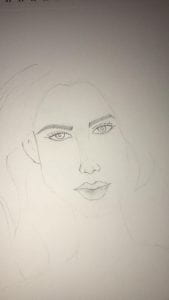From the tiny coloring books when I lived in Beijing to attending a fashion school when I lived in New York City, art is one of the only things in my life that has stayed constant. Since my dad is a diplomat, change was the biggest word in my life when I was growing up. Every three years when we moved to a new place, I had to make new friends, a new home, and a whole new routine. Art has stayed my “best friend” for years.
Today, I decided to work on my shading & portrait skills. Since I haven’t drawn faces in a long time, I was delighted to find free time to work on my art. To start off, I decided to use a video that teaches you how to make guidelines which can then be utilized to create the structure of the face. The link to the video is attached below.
shading + guidelines yt vid: https://www.youtube.com/watch?v=-c3L90nsesw

After creating the guidelines, the structure of the face was more even and proportionate. It also helped to add depth to the face and create features of the face intricately. As you can see in the drawing above, the facial features drawn lightly. As soon as I was done with the basic structure of the face, I was able to move on to shading and making it darker and ,ore detailed. This helped to make the face more realistic because I was able to learn how to shade and add the different lightings on her face. In overall, I think i did pretty good for a person who hasn’t done shading in a long time. In addition, I think it was a destressing activity that helped me take a break from school work and have more fun especially in the midst of the COVID lockdown. With more practice, I think I can improve on my skills and make my artwork more realistic and detailed.
Learning outcomes observed:
1. Strength & growth
LO1 Identify own strengths and develop areas for growth. Students are able to see themselves as individuals with various abilities and skills, of which some are more developed than others.
2. Challenge and skills
LO2 Demonstrate that challenges have been undertaken, developing new skills in the process
A new challenge may be an unfamiliar experience or an extension of an existing one. The newly
acquired or developed skills may be shown through experiences that the student has not previously
undertaken or through increased expertise in an established area.
3. Initiative & planning
LO3 Students articulate the stages from conceiving an idea to executing a plan for a CAS experience or series of CAS experiences. This may be accomplished in collaboration with other participants. Students may show their knowledge and awareness by building on a previous experience, or by launching a new idea or process.
7. Recognize and consider the ethics of choices and actions
LO7 Recognize and consider the ethics of choices and actions Students show awareness of the consequences of choices and actions in planning and carrying out CAS experiences.
